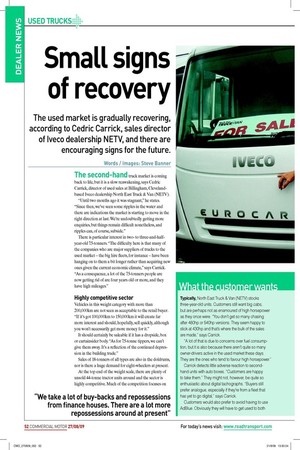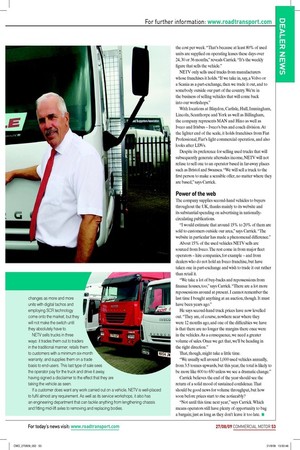Small signs of recovery
Page 56

Page 57

If you've noticed an error in this article please click here to report it so we can fix it.
The used market is gradually recovering, according to Cedric Carrick, sales director of Iveco dealership NETV, and there are encouraging signs for the future.
Words / Images: Steve Banner The second-hand truck market is coming back to life, but it is a slow reawakening, says Cedric Carrick, director of used sales at Billingham, Clevelandbased Iveco dealership North East Truck & Van (NETV).
“Until two months ago it was stagnant,” he states. “Since then, we’ve seen some ripples in the water and there are indications the market is starting to move in the right direction at last. We’re undoubtedly getting more enquiries, but things remain dificult nonetheless, and ripples can, of course, subside.” There is particular interest in twoto three-and-halfyear-old 7.5-tonners. “The dificulty here is that many of the companies who are major suppliers of trucks to the used market – the big hire leets, for instance – have been hanging on to them a bit longer rather than acquiring new ones given the current economic climate,” says Carrick. “As a consequence, a lot of the 7.5-tonners people are now getting rid of are four years old or more, and they have high mileages.”
Highly competitive sector
Vehicles in this weight category with more than 200,000km are not seen as acceptable to the retail buyer. “If it’s got 100,000km to 150,000km it will create far more interest and should, hopefully, sell quickly, although you won’t necessarily get more money for it.” It should certainly be saleable if it has a dropside, box or curtainsider body. “As for 7.5-tonne tippers, we can’t give them away. It’s a relection of the continued depression in the building trade.” Sales of 18-tonners of all types are also in the doldrums, nor is there a huge demand for eight-wheelers at present.
At the top end of the weight scale, there are plenty of unsold 44-tonne tractor units around and the sector is highly competitive. Much of the competition focuses on the cost per week. “That’s because at least 80% of used units are supplied on operating leases these days over 24, 30 or 36 months,” reveals Carrick. “It’s the weekly igure that sells the vehicle.” NETV only sells used trucks from manufacturers whose franchises it holds. “If we take in, say, a Volvo or a Scania as a part-exchange, then we trade it out, and to somebody outside our part of the country. We’re in the business of selling vehicles that will come back into our workshops.” With locations at Blaydon, Carlisle, Hull, Immingham, Lincoln, Scunthorpe and York as well as Billingham, the company represents MAN and Hino as well as Iveco and Irisbus – Iveco’s bus and coach division. At the lighter end of the scale, it holds franchises from Fiat Professional, Fiat’s light commercial operation, and also looks after LDVs.
Despite its preference for selling used trucks that will subsequently generate aftersales income, NETV will not refuse to sell one to an operator based in far-away places such as Bristol and Swansea. “We will sell a truck to the irst person to make a sensible offer, no matter where they are based,” says Carrick.
Power of the web
The company supplies second-hand vehicles to buyers throughout the UK, thanks mainly to its website and its substantial spending on advertising in nationallycirculating publications.
“I would estimate that around 15% to 20% of them are sold to customers outside our area,” says Carrick. “The website in particular has made a phenomenal difference.” About 15% of the used vehicles NETV sells are sourced from Iveco. The rest come in from major leet operators – hire companies, for example – and from dealers who do not hold an Iveco franchise, but have taken one in part-exchange and wish to trade it out rather than retail it.
“We take a lot of buy-backs and repossessions from inance houses, too,” says Carrick. “There are a lot more repossessions around at present. I cannot remember the last time I bought anything at an auction, though. It must have been years ago.” He says second-hand truck prices have now levelled out. “They are, of course, nowhere near where they were 12 months ago, and one of the dificulties we have is that there are no longer the margins there once were in the vehicles. As a consequence, we need a greater volume of sales. Once we get that, we’ll be heading in the right direction.” That, though, might take a little time.
“We usually sell around 1,000 used vehicles annually, from 3.5 tonnes upwards, but this year, the total is likely to be more like 600 to 650 unless we see a dramatic change.” Carrick believes the end of the year should see the return of a solid mood of sustained conidence. That should be good news for volume throughput, but how soon before prices start to rise noticeably?
“Not until this time next year,” says Carrick. Which means operators still have plenty of opportunity to bag a bargain; just as long as they don’t leave it too late. ■
What the customer wants
Typically, North East Truck & Van (NETV) stocks three-year-old units. Customers still want big cabs, but are perhaps not as enamoured of high horsepower as they once were. “You don’t get so many chasing after 480hp or 540hp versions. They seem happy to stick at 430hp and that’s where the bulk of the sales are made,” says Carrick.
“A lot of that is due to concerns over fuel consumption, but it is also because there aren’t quite so many owner-drivers active in the used market these days. They are the ones who tend to favour high horsepower.” Carrick detects little adverse reaction to secondhand units with auto boxes. “Customers are happy to take them.” They might not, however, be quite so enthusiastic about digital tachographs. “Buyers still prefer analogue, especially if they’re from a fleet that has yet to go digital,” says Carrick.
Customers would also prefer to avoid having to use AdBlue. Obviously they will have to get used to both changes as more and more units with digital tachos and employing SCR technology come onto the market; but they will not make the switch until they absolutely have to.
NETV sells trucks in three ways: it trades them out to traders in the traditional manner; retails them to customers with a minimum six-month warranty; and supplies them on a trade basis to end-users. This last type of sale sees the operator pay for the truck and drive it away, having signed a disclaimer to the effect that they are taking the vehicle as seen.
If a customer does want any work carried out on a vehicle, NETV is well-placed to fulfil almost any requirement. As well as its service workshops, it also has an engineering department that can tackle anything from lengthening chassis and fitting mid-lift axles to removing and replacing bodies.


























































